Japan has a prolific industry for collectibles and merchandise, although it is a fairly insular market that western collectors might find tricky to break into. There are always new surprises to uncover from riches of new releases each year. One such item which caught my attention in 2022 was a set of minifigures produced by The Access, a company dedicated to planning, manufacturing, and wholesaling a variety of in-house products for multiple age ranges. This new dinosaur set was the latest in The Access’s 3D Pictorial Book series, which are low-priced but nicely-packaged playsets aimed at kids ages 6 and up. I can’t exactly count myself as a child anymore, but I was curious if this set could appeal to adult sensibilities too.
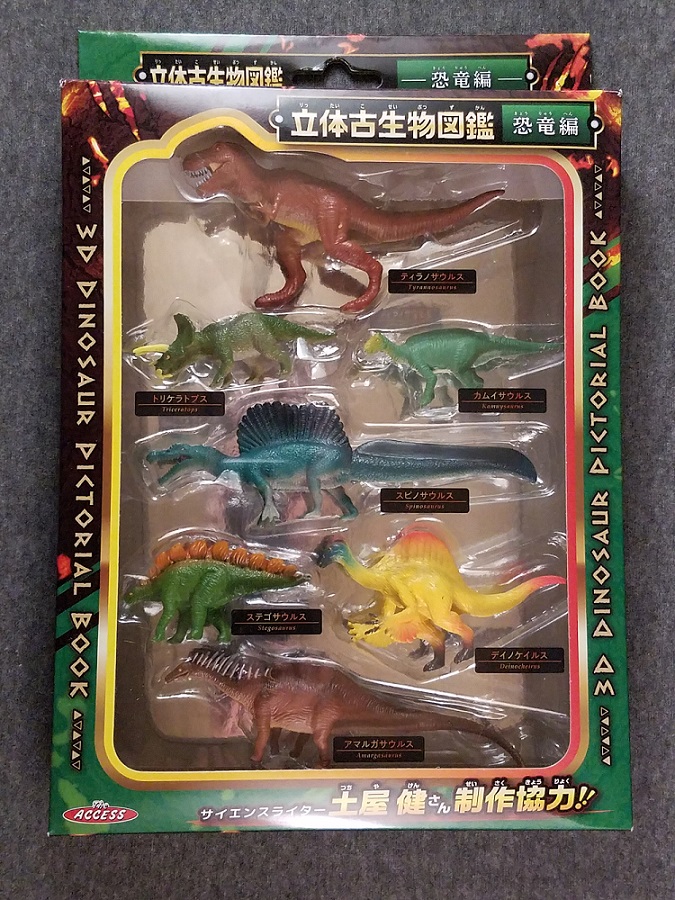
Despite the “Pictorial Book” moniker, The Access’s toy set does not include any written supplements, besides some basic genera descriptions on the back of the package. A total of seven dinosaurs are featured in the set, securely displayed in a window box with each genus name in Japanese and English. The box has a hanging hole for storage, and be opened from the top or bottom to slide out the plastic tray containing the toys.
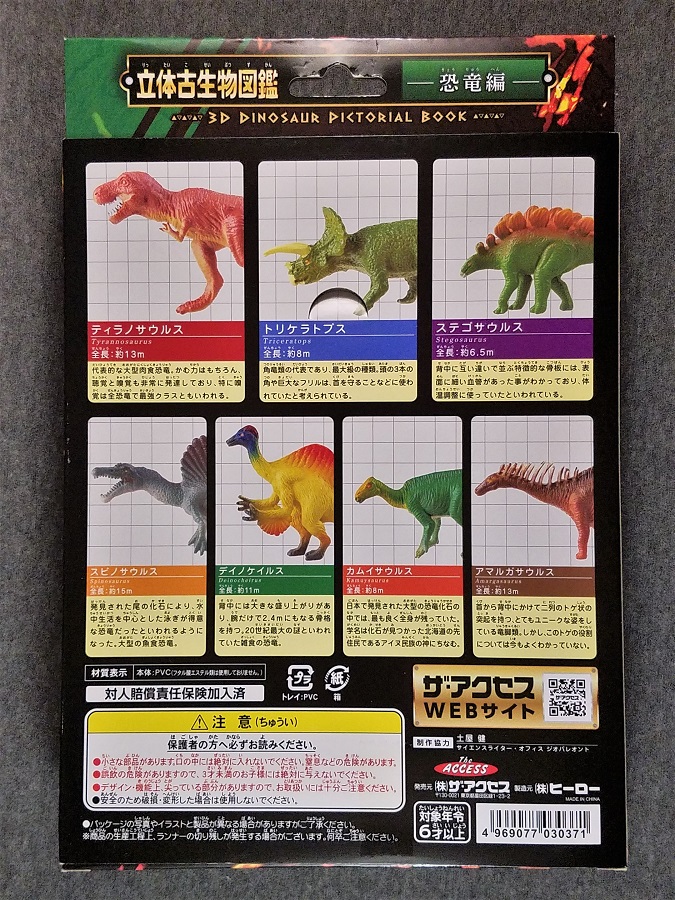
It’s a given that almost any set of dinosaur toys will feature a Tyrannosaurus, and this Pictorial Book set is no exception. The T. rex included in this set measures 11 cm (about 4.25 in) long and stands 5 cm (2 in) tall at the head, with its tail raised high off the ground and the body angled slightly above horizontal position. This is a very lanky, 1990s-era style of T. rex, with a shallow belly and hip bone contrasted by athletically exaggerated long legs. To the figurine’s credit, it stands perfectly stable on most hard surfaces, even though it’s sculpted to be walking on its tiptoes. The head is a little bulbous and wide, but still captures the signature T-bone shape of the skull and forward-facing eyes; a seam line running from the top of the head is a bit of eyesore. The arms are decently small, and thankfully avoid the all-too-common mistake of pronated hands. Texturing consists of generally striated skin, which looks less wrinkled and more shrink-wrapped on this slender body build (thankfully no bone outlines are exposed, though). Coloration is a flat red with a yellow underbelly, punctuated with beady orange eyes. Overall this is recognizable enough as Tyrannosaurus, but it’s hardly one of the better versions on the market right now, even at its given size.

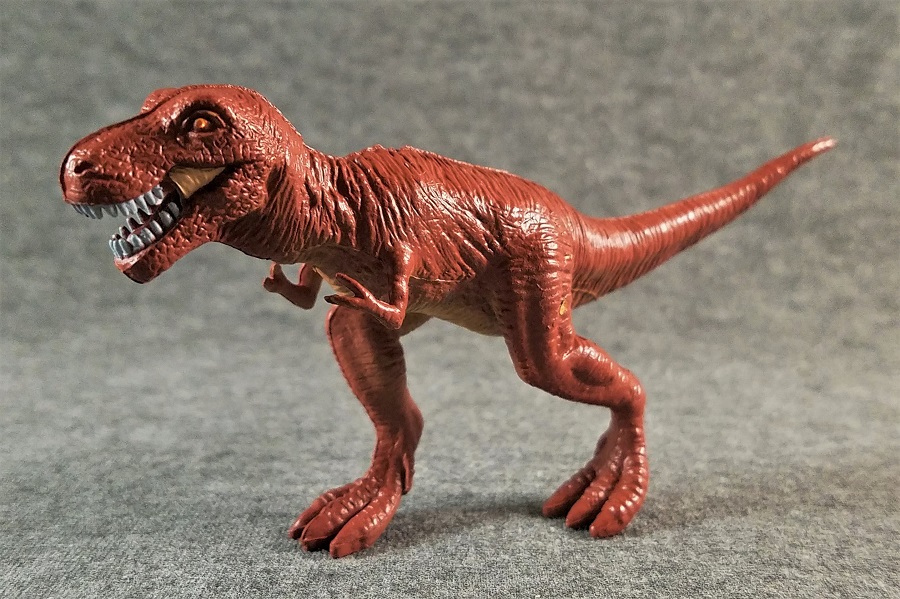
Along for the ride with Tyrannosaurus is the tyrant’s iconic rival, the herbivore Triceratops – although the three-horned face appears rather mismatched for this set, measuring a mere 7 cm (2.75 in) in total length. Like its theropodian contemporary, however, the Triceratops looks a little lean on the physique – although the general anatomy looks more decent. The species of Triceratops is not given on the package (at least not in English); the beak and nose horn appear closer to T. prorsus than the more popular T. horridus, but the brow horns and overly curled bony frill don’t really match either species. The back is very shallow and level, lacking the genus’s rounded torso, whereas the tail is generously long and fleshed out. Coloration is a basic green gradient with off-white horns and beak, as well as beady orange eyes (again). This petite horned dinosaur is another serviceable representation, but nothing remarkable.

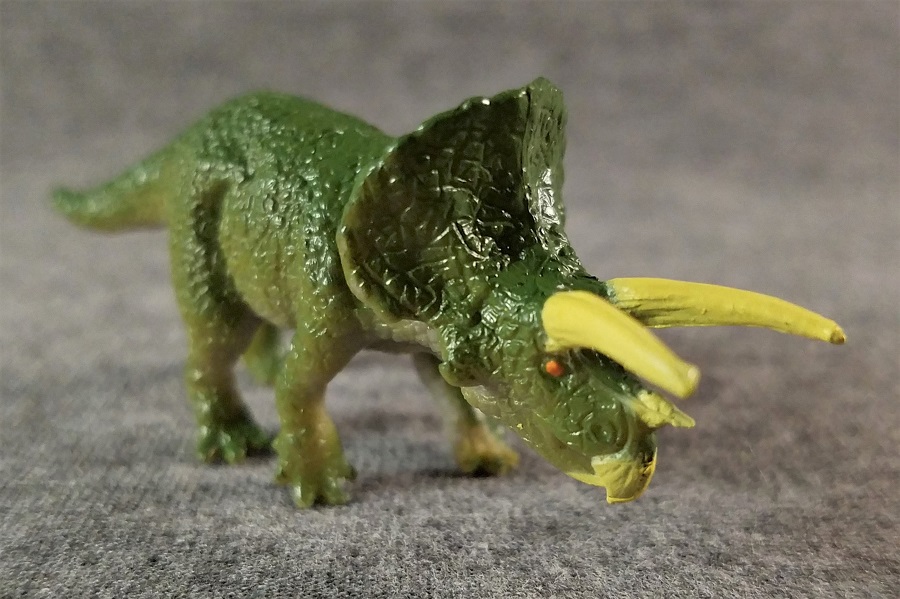
A somewhat more remarkable – and significantly larger – figurine in the set is Spinosaurus, which stretches 13 cm long (>5 in – contending for longest figure in the set) and bearing many of the peculiar features newly described for the genus in the past several years. Long-bodied, fin-tailed, M-sailed and functionally quadrupedal, Spinosaurus was one of the strangest-looking theropods, and a number of Japanese companies have been quick to adopt the new imagery for the famous predator, The Access now included. Although many of these traits continue to be disputed, it’s evident The Access was at least paying reasonable attention to the theories and discoveries, delivering a much more contemporary rendition than seen in the Tyrannosaurus or Triceratops. My biggest caveat with the sculpt would be regarding the hands and feet, which appear nondescript and lacking the distinctive claws and toes known of the genus and its extended family; then again, these are tiny hands and feet, so I won’t be too hard about it. Texturing on the figurine is a pebbly scaly surface, with a more ridged texture for the sail and belly, plus a smooth tail fin. Coloration is still pretty plain, with the selected gradient being a dark-to-whitish sea blue, punctuated once again with bright orange eyes. I’d say Spinosaurus is one of the better-looking dinosaurs in the set, overall.
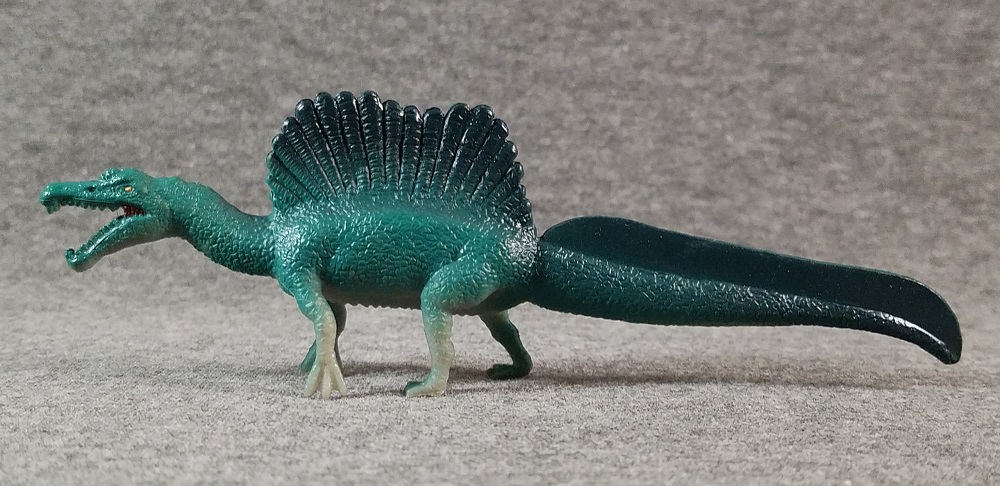
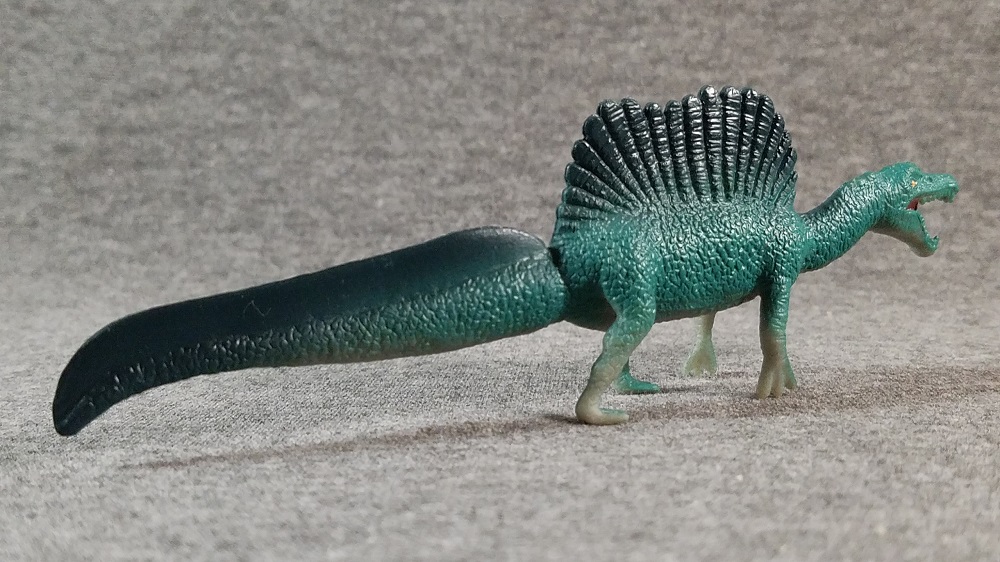
Another peculiar-looking figurine in the set is Stegosaurus – but unlike the Spinosaurus, I think this case was accidental. The roofed reptile is depicted with some downright wonky proportions, including uniformly small plates, a stunted neck, and forelegs as long as the hind legs. If the Spinosaurus was evidence of The Access paying attention to current science, than I’m tempted to say Stegosaurus indicates the exact opposite; it’s no retrosaur, but this is quite the distorted take on pre-Sophie skeletal reconstructions. To the figurine’s credit, at least the number of plates appears accurate, and a beak is painted (if not sculpted) on the end of the diminutive snout. The dinosaur is lightly textured with wrinkly skin, and colored solid green with an orange spray along the back and plates – something of an odd cliché Stegosaurus get caught with. Frankly speaking, Stegosaurus is probably one of the worse figures in this set.
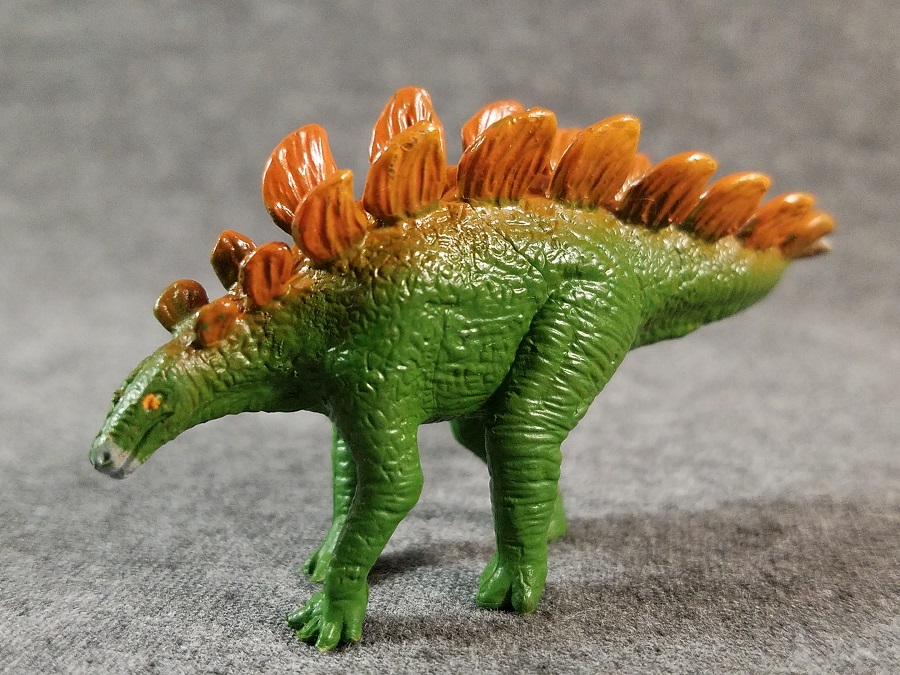
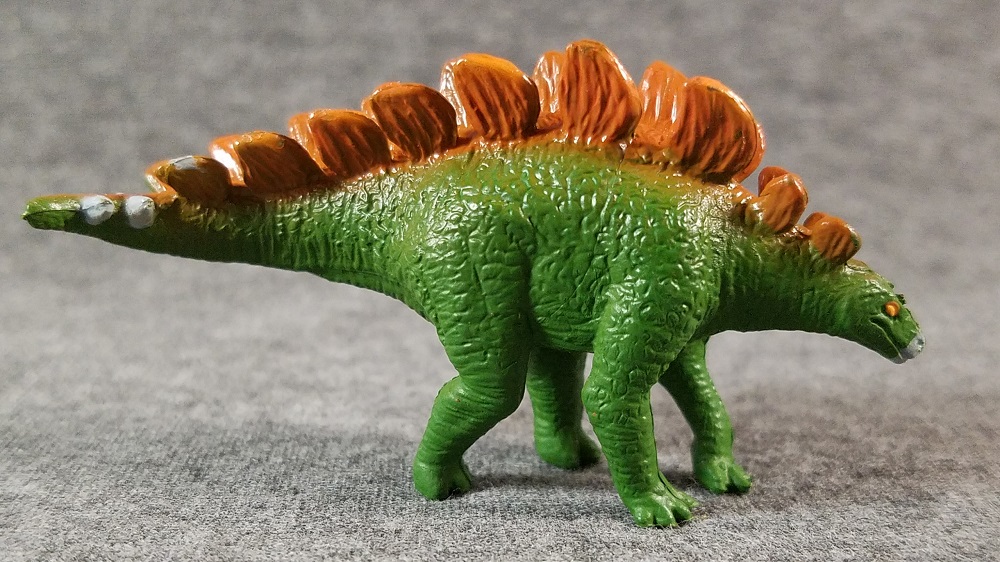
Probably my favorite selection from the 3D set is Deinocheirus, one of the most peculiar-looking dinosaurs yet to be (re)described and something of a minor rising star in paleontology from the last few years. The Deinocheirus of this set measures just over 8 cm (3.25 in) long, so about mid-sized for these figurines. Generally speaking, the signature anatomical traits of the genus are captured here: the stout body, massive arms, long neck, and curious sail structure. The sail and the arms seem a little exaggerated in size, though; and the skull appears badly blunted from the hefty spoon-billed beak now recognized of the genus. The figure stands pretty well, but is a little less stable than the larger Tyrannosaurus. A coat of shaggy feathers is sculpted across the body, with long primary feathers on each arm; however no extra feathers are featured to indicate the pygostyle structure at the end of the tail. Coloration for the figurine is primarily bright yellow, with red highlights to the arms, sail, and tail tip, plus a dark blue for the head and feet. This flamingo-esque color scheme may be turning into another stereotype for this genus (like green & orange/red for Stegosaurus), between multiple toys imitating either Collecta’s models from 2016 & 2017 or the version of the dinosaur depicted in the NHK’s Amazing Dinoworld documentary. Color “memes” aside, though, it’s nice to have another toy of this quirky dinosaur on the market.

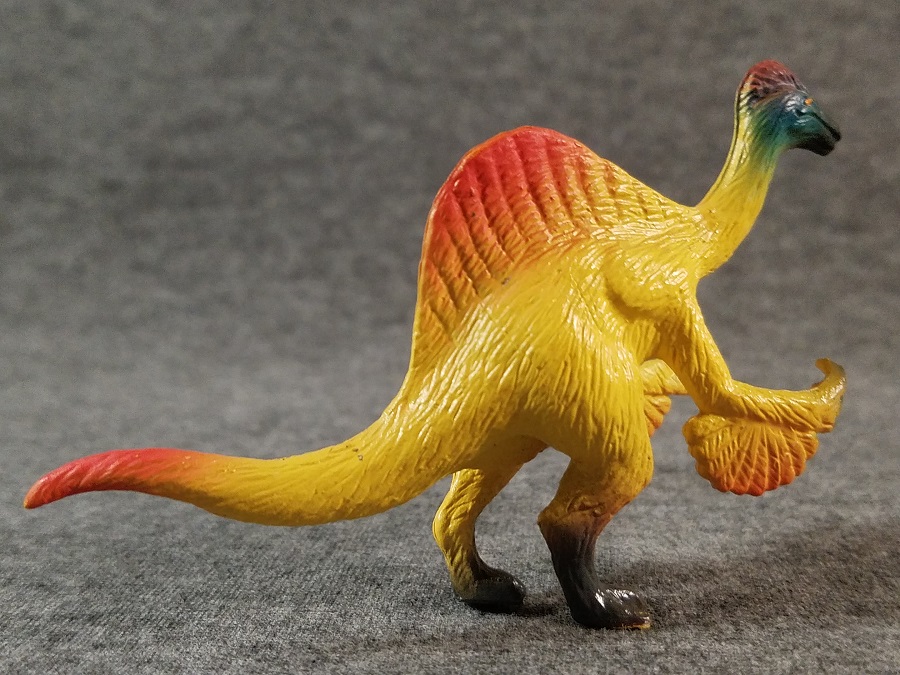
The most unique figurine in this set might be Kamuysaurus, a little-known but highly complete hadrosaur discovered in Japan as recently as 2019. At 7 cm (2.75 in) long, Kamuysaurus isn’t the most striking figurine of the set; but for the most part the sculpt appears accurate to the known skeletal remains, including the high ridge of the back and long, graceful forelegs. If anything the torso might be a bit long while the tail is a bit short; but these feel like quibbles compared to the odd proportions on some of the set’s other figurines. Coloration is flat green with a creamy underbelly, but some light orange on the face breaks up the monotony. Personally I think it’s nice to see Japanese companies like this one making the effort to endorse a new (and native!) discovery, and introduce it to young audiences alongside more classic dinosaurs.

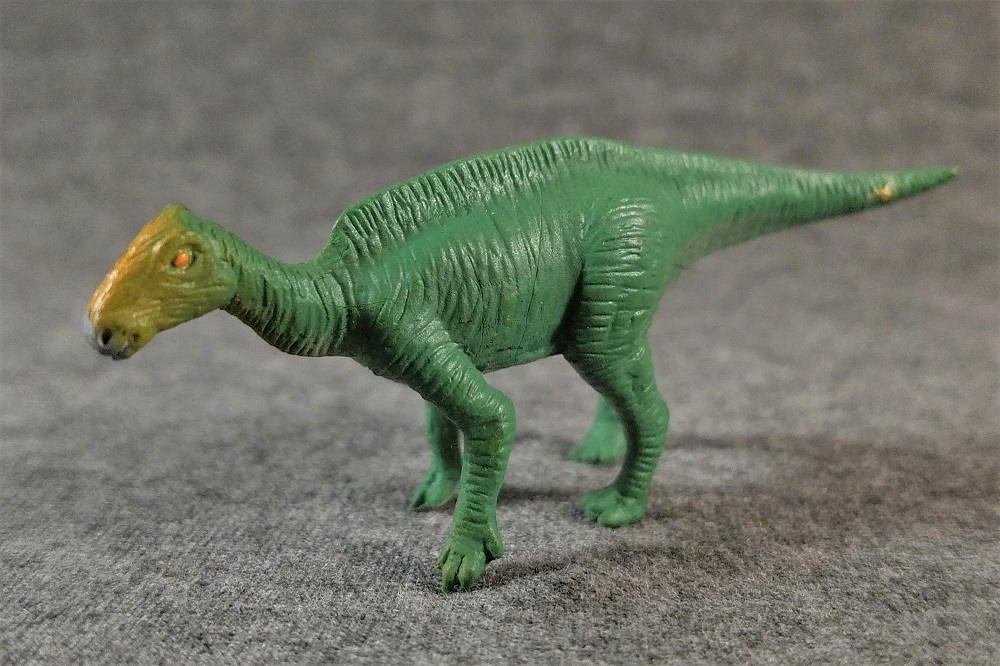
The final dinosaur in the Pictorial Book set is the sauropod Amargasaurus, another unusual dinosaur with a growing reputation. The Amargasaurus is tied with Spinosaurus for longest figurine, measuring around 13 cm in length counting the curve of the tail. While it’s pleasing to see another “B-rank” dinosaur among a few big stars, this long-necked dino appears to have gotten the short end of the stick in some design details. The main body is reasonable enough in appearance, and the tail is pleasantly long and whiplike. Follow the neck out, however, and past the double row of vertebral spikes you get to a head sculpt that’s positively lizardlike. The skull is long with deep-set jaws, and the orange eyes seen on every figurine in the set give Amargasaurus a particularly creepy visage against the dark reddish-brown body coloration. The neck spines are also rather sloppy, with irregular sizes that poorly reflect the patterns seen in fossils. A common mistake for sauropods is also applied to the front feet, which bear multiple toes instead of a single pad with thumb. It’s possible I’m being a little too harsh here, though, compared to the rest of the set. Sculpting in miniature has bound to be challenging, and most of the intended customer audience probably won’t be concerned about these details yet. At the end of the day, this figurine is still easily recognizable as Amargasaurus, so the kids can learn more about the nuances of accuracy another day.
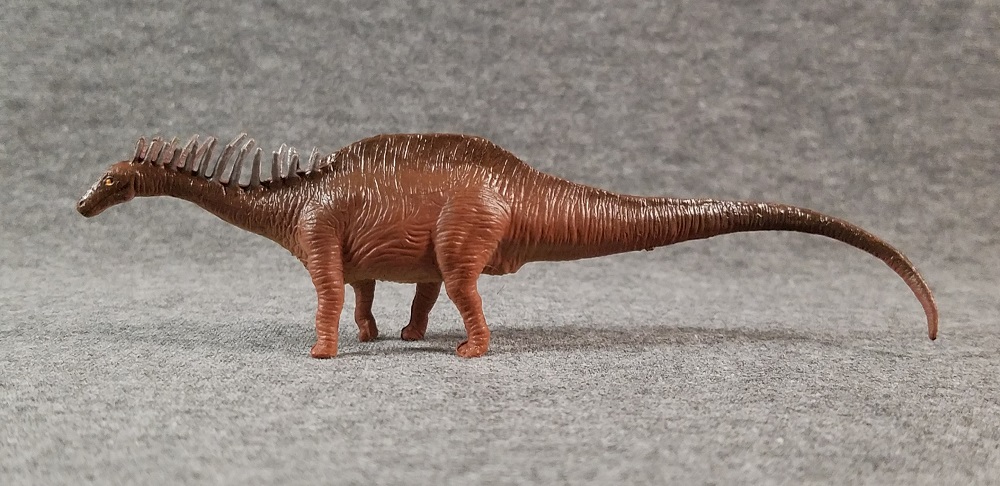
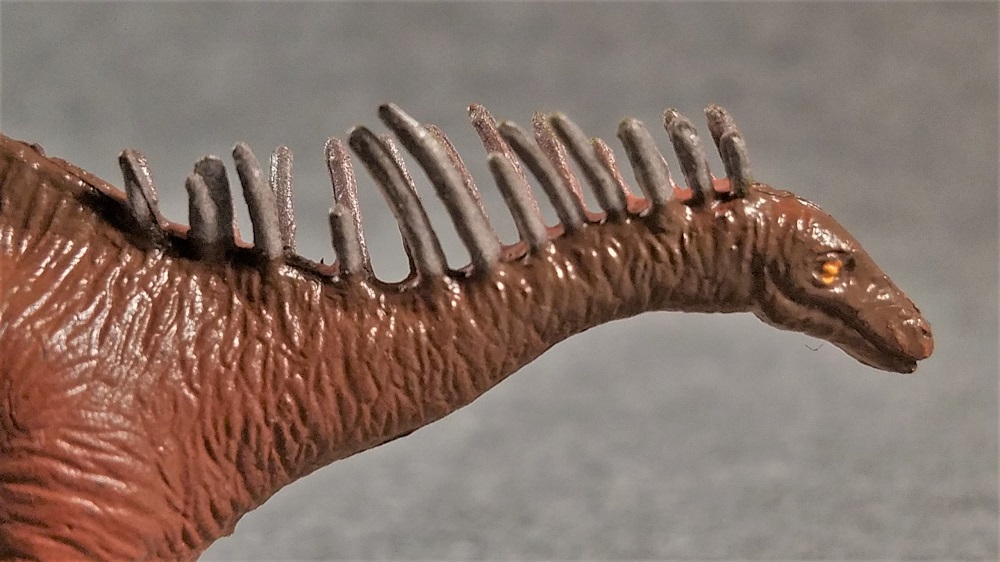
The Access’s 3D Pictorial Dinosaur Book comes finely packaged and features a neat array of dinosaur genera; however the individual figures can be somewhat crude in design, and are best viewed as cheap playthings for young-but-eager dino fans in the making. If one feels so compelled to still seek out the set for oneself (or one’s kids), try searching eBay or, better yet, Mecari and Yahoo Japan for listings. One can also check The Access’s main website, or look into possibilities with 3rd-party vendors.
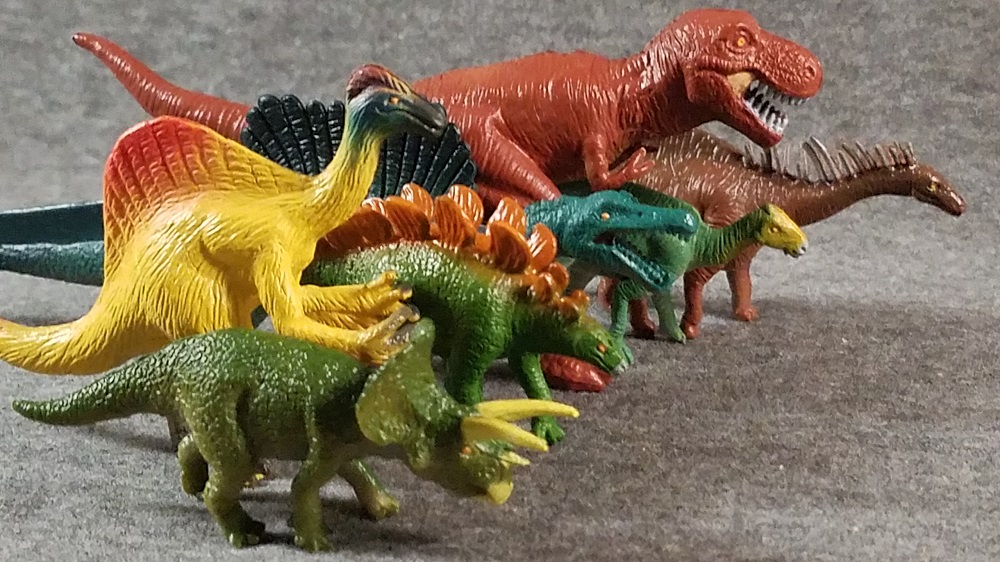
Support the Dinosaur Toy Blog by making dino-purchases through these links to Ebay and Amazon. Disclaimer: links to Ebay.com and Amazon.com on the Dinosaur Toy Blog are often affiliate links, when you make purchases through these links we may make a commission

Nice review of a set I wouldn’t have known about otherwise! Anatomy flubs aside, I think these are quite charming. I actually really enjoy very colorful dinosaur toys – I guess that’s something I never grew out of, haha. Might even look into getting these for myself, thanks!
It’s my pleasure to be of service! I enjoy covering some of the more obscure and unusual items out there, as someone who has often been left wanting for details on such items myself in the past. I’m delighted to know the reviews are of use to others!